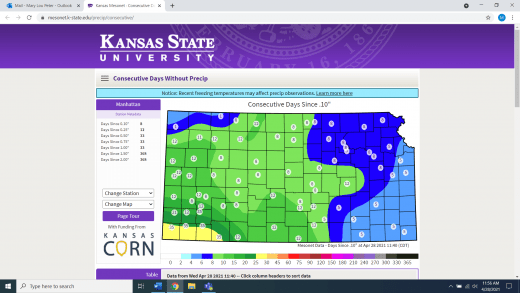In this week’s Better Kansas, we take a look at how trails can lead to economic development, foods that fight inflammation, sweet potato bread, the surprising benefits of a healthy lawn, soybean planting considerations and a handy way to track precipitation across the state. This is a small glimpse of what K-State Research and Extension across the state has to offer. Share on social media and subscribe! – Mary Lou Peter mlpeter@ksu.edu
Better Living, Better Communities
ONE THING THIS PANDEMIC SPARKED IS THAT MORE PEOPLE SEEM TO BE OUT WALKING, jogging, and bicycling than ever before. My neighborhood is pleasant but walking the same streets for so many years gets a little repetitious, so it’s nice to explore different trails in the area. Communities across the country are using peoples’ interest in exploring trails to help fuel economic activity as well as community pride and mental and physical health. An example of how that’s working in Ottawa, Kansas was featured in a recent First Friday e-Call on the role of trails in community development and in an article posted online. Exploring a new trail followed by a little shopping and pleasant dinner in a new community sounds good to me!
INFLAMMATION HAS AN IMPORTANT ROLE IN OUR BODIES as it often signals that we’re fighting the effects of arthritis, an injury or infection. But when inflammation becomes chronic, it’s literally a pain and can take such a toll on our daily lives. What we eat can help mitigate inflammation, however. Take a look at Top 10 foods that fight inflammation. I KNEW there was a reason I like almonds and dark chocolate … especially together! That whole portion control thing is another topic.
SWEET POTATOES IN BREAD? MAYBE A WIN-WIN! Mostly in Better Kansas, I feature the work of K-State researchers and educators. Occasionally, however, the work of other universities catches my eye and that’s what happened when I read about work done at South Dakota State University, another land grant school doing great work, this time incorporating sweet potato puree into bread. It adds Vitamin A and changes the starch composition by increasing the fiber content. Read about how that might be beneficial for those dealing with diabetes. I’ve become a big fan of sweet potatoes in pretty much every form, so this just reinforces my interest.
Better Farming, Ranching and Gardening
WHAT HELPS KEEP US COOLER IN SUMMER, FILTERS CONTAMINANTS AND REDUCES NOISE? The answer is surprisingly simple: a healthy lawn. Plus, it looks beautiful, feels great and smells good, especially right after mowing. Take a look at Benefits of Healthy Turfgrass to learn more surprising positives about something that many of us take for granted. I once lived in northern California, where water is often scarce. Some of my neighbors had resorted to a front yard full of rocks and a back yard of concrete or artificial turfgrass. It was understandable but for this native Midwesterner, it reinforced a feeling of being a stranger in a strange land. More information about planting and maintaining healthy lawns is also available on the Turfgrass and landscape blog.
LUCKILY FOR SOYBEAN GROWERS, THOSE BEANS CAN BE PLANTED OVER A WIDE RANGE OF DATES, but they’re a little finicky about soil temperatures. Kansas growers are tending to plant slightly earlier than they used to. A recent Agronomy eUpdate article covers K-State recommendations for soybean planting dates and maturity groups and offers visually descriptive maps. As of the week ending April 25, Kansas producers had planted 2% of the soybean crop which was equal to last year and near the 1% average, according to USDA’s National Agricultural Statistics Service. Soil moisture, another critical component of a successful crop, was generally rated adequate to surplus. Topsoil was rated 5% surplus, 76% adequate, 13% short and 6% very short. Subsoil moisture was rated 5% surplus, 73% adequate, 14% short and 8% very short.
 KANSAS MESONET NOW HAS A NEW TOOL THAT TRACKS THE NUMBER OF CONSECUTIVE DAYS we’ve had across the state without precipitation. That’s helpful for farmers, gardeners, homeowners and other weather watchers. The Consecutive Days without Precip page takes the guesswork out of trying to remember if that quarter inch shower was two weeks ago Friday … or was it the previous Tuesday? A recent Kansas Farmer magazine article highlighted the new feature.
KANSAS MESONET NOW HAS A NEW TOOL THAT TRACKS THE NUMBER OF CONSECUTIVE DAYS we’ve had across the state without precipitation. That’s helpful for farmers, gardeners, homeowners and other weather watchers. The Consecutive Days without Precip page takes the guesswork out of trying to remember if that quarter inch shower was two weeks ago Friday … or was it the previous Tuesday? A recent Kansas Farmer magazine article highlighted the new feature.
_
For more resources and activities, contact the K-State Research and Extension office in your area. Check out our other blogs and subscribe to our weekly emails here: https://www.ksre.k-state.edu/news/blogs/










